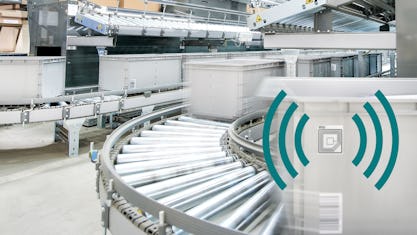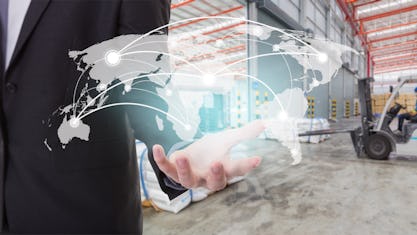Possible applications of AI in logistics
Artificial intelligence is considered a key technology with far-reaching effects on the national economy and competitiveness. Areas of application for the technology include predictive logistics, smart warehouses and robotics.

Artificial intelligence (AI) is on everyone's lips as a technology of the future. Based on self-learning algorithms, AI can already be found in many everyday applications and products. Examples include: voice assistants, smart homes, music streaming, Facebook feed and ads, Amazon's product suggestion algorithm, language translation, image creation/recognition, assisted and autonomous driving and navigation. AI (1) includes an increasing number of subfields: bots, predictive maintenance, data mining, process mining, neural networks, machine learning, deep learning, and many more. Deep learning with the help of neural networks is currently the most promising AI approach, which is also used within machine learning.
Artificial intelligence increases competitiveness
The McKinsey Global Institute (MGI) sees AI as an important driver for global economic growth. Its study "Artificial Intelligence – The next digital frontier" (2), surveyed 3000 companies from 14 industries. It found the five AI technologies that will be used most frequently by companies in the future are: automatic image recognition, natural language, virtual assistants, robot-based process automation and advanced machine learning. By 2030, approximately 70 percent of companies will use at least one of these AI technologies. According to the study’s authors, companies that implement AI technologies early can double their cash flow, while laggards would see their cash flow decline by about 20 percent from today's levels. “AI could be a significant driver of productivity and GDP growth for the UK economy”, according to ‘Artificial intelligence in the United Kingdom: Prospects and challenges’ (3), which was prepared by MGI for London Tech Week, June 2019. It estimates that “the economy could see an uplift of about 22 percent of current GDP by 2030. That improvement would be a welcome boost in the United Kingdom, given its weak recent record on productivity growth”. The study finds the UK’s relative readiness is the result of its position on seven AI enablers. Three are AI-specific: research activities, start-up investment, and automation potential. The other four are foundations for AI: digital absorption, innovation foundation, human capital, and information and communications technology (ICT) connectedness. However, the rate of technology adoption amongst many UK businesses is slow, which could impact their ability to compete on an international scale, according to the Future in 2020 (4), BT’s definitive annual review of how UK businesses are working with emerging technology. Surveying over 1,000 businesses, ranging from SMEs to large enterprises, the study reveals “digital immaturity of some UK businesses, driven by a lack of awareness of key emerging technologies amongst business leaders and a failure to link technology benefits with improved business performance.” The review goes on to show a digital divide, with large organisations (1,000+ employees) much more likely to be using transformational technology than small companies (10-49 employees). In sector terms however, transportation and distribution (32 percent) is slightly higher than the average sector adoption rate.
Artificial intelligence stabilises economy during Corona pandemic
"The Corona crisis has shown us very clearly the importance of digital technologies for the economy, administration and society,“ said President Achim Berg, President of the German digital association Bitkom. “The crisis is a wake-up call to now massively push ahead with digitisation. We have taken too much time with digitalisation in the past." He added: "We have to think about the time after the Corona crisis and set the course for digitalisation everywhere. We can currently see very clearly that more digitised companies and the digital economy are much more than a growth engine. They are less vulnerable in times of crisis, they stabilise the economy and the labour market." According to a study carried out in Germany by TCS and Bitkom (5), a majority of companies (75 percent) have already increased their investments due to the pandemic. Only a minority (7 percent) are slowing down the digital transformation for the time being due to a lack of finances.
Artificial intelligence in the logistics industry
While "artificial intelligence" has been around as a term and field of research since the 1950s, the current boom in AI is a consequence of the powerful hardware now available at low cost. Only now are processors, high-speed networks and Big Data storage options available, making the practical implementation of many theoretical considerations possible. AI and its algorithms are particularly suitable for use in logistics, as cause-effect relationships in these networks can be calculated and predicted. "Logistics is already one of the most digitised business sectors. But with drones, autonomous systems and artificial intelligence, logistics is not only facing an optimisation of business processes, but a real revolution," said Bitkom CEO Dr Bernhard Rohleder. A representative survey (6) of 508 companies with logistics processes, which was commissioned by Bitkom, shows that two-thirds (65 percent) of the companies believe that self-learning AI systems will take over many tasks in logistics, such as planning the best route or triggering order processes. 75 percent expect data glasses to support employees in logistics. Six out of ten (58 percent) companies expect autonomous drones to take inventory of stock. A similar number (57 percent) expect goods to be transported by autonomous vehicles. Four out of ten (42 percent) believe that drones and delivery robots will even bring the products to the customer. Companies appreciate the many advantages of digitalisation and artificial intelligence. 89 percent expect a reduction in logistics costs and an acceleration of transport in the long term (86 percent). 72 percent anticipate fewer errors in the transport chain and 58 percent see more environmentally friendly transport. Digitisation as a whole is seen as an opportunity by 88 percent and as a risk by only 11 percent. Some examples of the use of AI in logistics and intralogistics are presented below.
Predictive Logistics
AI is particularly useful for predicting the future state of a logistics network. Self-learning AI algorithms can evaluate large amounts of data – often termed ’Big Data’ – that describe customer behaviour in the past. By recognising patterns in this data it is possible to predict the occurrence of events, such as ordering behaviour, with a certain amount of probability. This is known as predictive analysis, and it allows the creation of computer-generated future models of a logistics system or a supply chain. From these models, intelligent decisions can be made about future actions. For example, it is possible to predict in which region a certain item will be ordered particularly frequently. This informs logistics operations about requirements for storage space, trucks, warehouse staff, etc and it can trigger necessary actions, such as storing items in a warehouse located close to the customer's location before they are ordered, to reduce delivery times. Risk management for an entire supply chain can also be made more anticipatory. For example, live data from the supply chain, such as information received from tracking sensors reporting the condition of the goods being transported, can be combined with traffic reports incorporated into the data models to determining the appropriate measures to take. This simulation-based intelligent planning is already revolutionising the logistics industry, as well as many other sectors.
AI robots
Robots equipped with AI or deep learning algorithms can make intelligent autonomous decisions regarding the identification, analysis and counting of goods, in addition to performing their handling and transport roles. This means they can, for example, be used to track, locate and move inventory in warehouses. Picking robots, loading robots and cobots (collaborative robots) will shape the future of intralogistics. Autonomous picking robots, which are particularly relevant for small batch sizes, are often found in online retail. Cobots are increasingly supporting humans in their work in the warehouse. A good example is a cobot guiding an employee to the items within a picking zone. The AI-driven solution not only increases picking rates by 200 to 300 percent, but will also helps pickers work faster and more accurately.
Autonomous vehicles
Autonomous driving refers to fully automated driving of a vehicle – ie, no driver. In intralogistics, autonomous vehicles are called automated guided vehicles (AGVs). AGVs can massively reduce the number of empty and incorrect trips because the vehicles automatically drive to the correct shelf. They are guided by various technologies, such as indication strips, precision lasers, reflectors or simple adhesive tape tracks. While most intralogistic warehouses today still operate vehicles such as forklifts, which rely on a driver, AGVs follow an automatically programmed path that eliminates bottlenecks, collisions or other obstructions to the workflow. This speeds up a company's intralogistics and makes it more efficient. The challenge here lies solely in creating an open infrastructure. When it comes to transport logistics, autonomous vehicles and drones can be used for parcel delivery, among other things.
Visual Artificial Intelligence
AI can be used for damage detection and classification. It is much faster and more accurate than human damage assessors. One example is the use of visual artificial intelligence at internet giant Amazon. Here, containers holding items are unloaded within a very short time and their contents are categorised. Visual Artificial Intelligence or Deep Learning technology can be applied to object recognition without barcodes, for counting and measuring products. This can be used, for example, to automate goods receiving by independently identifying products, determining product dimensions and weight, and reading additional information if necessary. Packing processes can be accelerated, for example, by eliminating the need to scan products and displaying the 3D packing scheme or automatically scanning many barcodes and QR codes at once. Objects can be counted and measured simultaneously via AI and computer vision.
Smart Warehouse
The heart of a smart warehouse is an intelligent warehouse management system (WMS), which will increase productivity and efficiency. A WMS consistently visualises and uses data about logistical objects, detects anomalies before problems occur and processes the information to achieve efficient optimisations such as route time reduction. Automation solutions such as AI robots, AGVs, visual artificial intelligence, RFID, pick-by solutions, and augmented reality glasses can be integrated into a smart WMS. Also, integrating smart grids and intelligent cooling and heating systems will save electricity.
Literature:
1 How artificial intelligence is revolutionising logistics, Bito Expertise, Link
2 Bughin Jacques et al., Artificial Intelligence - The next digital frontier, McKinsey Global Institute, 2017, San Francisco Amsterdam Shanghai
3 ‘Artificial intelligence in the United Kingdom: Prospects and challenges’ – prepared by MGI for London Tech Week, June 2019, in collaboration with QuantumBlack and McKinsey & Company UK and Ireland
4 ’The Future In 2020 Review – the definitive review of how UK businesses are working with emerging technology’, by BT working with YouGov
5 Germany learns AI - How companies use digital technologies, Bitkom Research GmbH and Tata Consultancy Services, 2020, Frankfurt, www.studie-digitalisierung.de
6 Dr Rohleder Bernhard, Digitalisierung in der Logistik, Presentation, March 2017, Bitkom e.V., Berlin, download


